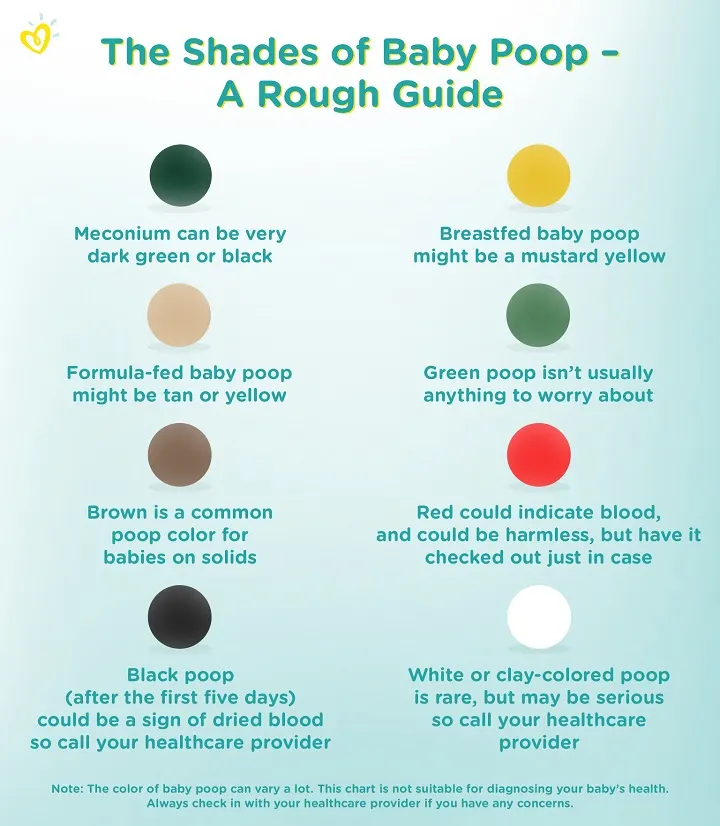Baby Potty — The A – Z Guide
Baby poop is probably something you were expecting to deal with as a parent, but did anyone tell you how varied the contents of your little one’s diapers could be?
Runny or firm, black, green, or yellow, your baby’s potty can come in many different shades and textures.
Those diaper changes are a big part of any parent’s daily routine, but they can also be an important way of keeping an eye on your baby’s health.
Learn what the color, consistency, and frequency of baby poop can tell you and your baby’s healthcare provider about your baby’s development and health.
Your Baby’s Poop — What’s Healthy?
You might be wondering what healthy baby poop should look like. It’s a fair question, because the color and consistency of your baby’s poop changes over time depending on various things, especially what your baby is eating.
Here’s a rough guide to what you’re likely to find in your little one’s diapers over the first few days, weeks, and months after your baby’s born.
Meconium
Your baby’s first few diapers will likely contain a gooey, dark-green, tar-like substance, with hardly any smell. This is called meconium.
This special kind of poop is made of things like the skin cells, mucus, lanugo hairs, and other particles your baby swallowed along with the amniotic fluid while still in the womb.
It takes a few days for your little one to pass all the meconium out of his system, but as this happens he’ll start to have regular poops. At this time, his poop will turn from being almost black to a yellowy green. Tell your healthcare provider if your baby’s first bowel movement doesn’t happen within the first 24 hours after birth.
Regular Baby Poop
Here is what you’ll probably find in your little one’s diapers:
Breastfed babies.
If you’re breastfeeding your baby, her stools in the first few months may look a little like Dijon mustard, with a slightly runny consistency, and possibly with whiteish, seed-like fat particles. The color of your baby’s poop may also change depending on what you’re eating. For example, if you eat green vegetables like spinach, you might see a green tint in the contents of your little one’s diapers.
Formula-fed babies.
If your baby is getting her nourishment from formula, her poop won’t usually be as runny as that of a breastfed baby. It will have a more paste-like consistency (although it shouldn’t be firmer than peanut butter) and a darker yellow or tan color.
Babies in the weaning stage.
When you start introducing your baby to solid foods, which is recommended from around 6 months, you’ll start to see (and smell!) some major changes in the contents of your baby’s poopy diapers. Her stools will get firmer, and their color will vary more widely, too. If your child is eating finger foods, you might see undigested bits of food like the skins of peas or tomatoes. This is because your little one’s digestive system is still getting the hang of processing all these new foods. The weaning period is also when your little one’s poop will start to smell stronger, due to the extra fats and sugars in her diet.
Green, Gray, Red — What the Colors of Baby Poop Can Mean
You might be surprised by a change in the color of your baby’s poop, which can range from the mustardy hues of breast-milk poop and the yellow-tan of formula-fed baby potty to various other shades of yellow, brown, and even green baby poop.
Green baby poop, in particular, can be alarming the first time you see it, but it’s usually harmless. All sorts of things can cause it, from certain medicines (taken by your baby, or by you if you’re breastfeeding) to green foods eaten by your baby directly or passed on through your breast milk. Sometimes, what you see is simply a product of your little one’s normal digestion.
As a general rule, all the earth tones (yellow through green and brown) are OK, but if you ever need reassurance about the color of your baby’s poop don’t be shy about reaching out to your healthcare provider for advice.
Warning Colors of Baby Poop
Certain colors of stool can be a sign of a possible health issue. Always check in with your healthcare provider if your baby’s poop is:
Red Baby Poop.
Traces of red can be due to blood in your baby’s feces, so it’s important for your baby’s healthcare provider to look into what might be causing it. Keep in mind, though, that there are plenty of harmless reasons for red poop. In a newborn baby, a little blood may have been swallowed during delivery. If you’re breastfeeding, it might be that your nipples are bleeding, and the blood is mingling with your breast milk. If your little one is eating solids, it could be some kind of food, such as beets, coloring her poop.
Black/Green Baby Poop.
A black stool could, in some cases, be caused by blood, which may turn from red to black inside the intestines over time. It's important to know that very dark green poop can sometimes appear black. Green baby poop — even a dark shade of the color — is usually nothing to worry about. Meconium can also look black, and this isn’t a problem.
White or gray Baby Poop.
Very pale white or clay-colored stools are very rare, but if you see poop this color in your baby’s diaper, call your healthcare provider, as it could be a sign of a liver condition that needs treatment.
How Often Should Your Baby Poop?
How often your baby does a “number two” will change as she grows and her digestive system develops, but it’s also affected by the feeding method that you use.
If You’re Breastfeeding Your Baby
Generally speaking, if your baby is breastfed, she’s likely to poop more frequently than her formula-fed peers. As a rule of thumb, after the first few days you might see anything between 2 and 5 bowel movements a day, up until your little one is around 6 weeks old.
Your baby may sometimes go several days between bowel movement after 3 to 6 weeks of age. Because your leaves very little solid waste as your baby’s digestive system is able to process breast milk very efficiently.
After 6 weeks your baby may do fewer poops every day. One reason for this is that by this time your breast milk usually no longer contains colostrum, which can act as a laxative.
If You’re Formula Feeding Your Baby
If your little one is getting all or most of her daily nutrition from formula feeding, after the first few days she may start filling her diaper at least once a day, but it’s not out of the ordinary for her sometimes to go a day or two without a bowel movement. This is OK, provided her stools are soft when they do materialize.
If you’re ever concerned about how many poops your little one is doing, chat with your healthcare provider.
Can Your Baby Make Too Much Poop?
The amount of poop your baby makes each time can vary. As long as his weight gain is on track, and the stools are soft, things are probably fine. If your baby’s poop seems watery, especially if he is pooping much more frequently than usual, or he has other symptoms, like a high temperature (100.4 degrees Fahrenheit or above), this could be diarrhea.
See your healthcare provider if you think your baby might have diarrhea, especially if he is under 3 months.
It’s worth knowing that newborns and younger babies are more likely to produce lots of little poops one after the other. If you notice that your baby’s just had a bowel movement, you might be able to save yourself an extra diaper change by waiting just a little longer in case there’s more to come.
Even if you do get caught out sometimes, no diaper is ever truly wasted! Each one could be earning you points that you can turn into gifts, coupons, and discounts.
When There’s No Poop — Constipation
With all the variation in how often your baby poops, you may sometimes wonder how you can tell if your little one is constipated.
Constipation is more common after the introduction of solids, but it can occur in younger babies, too. Here are some typical signs of constipation:
In a newborn baby.
Firm stools that come less than once a day.
In an older baby or toddler.
Hard, compact stools that only come every three or four days.
In a baby or child of any age.
Large, hard, and dry stools that are painful to pass. If there’s blood on or in your child’s stools. If your child strains for more than 10 minutes without passing any stool at all.
What Can You Do About Constipation?
If you think your baby is constipated, see your healthcare provider for advice. Don’t give your baby any medication, including a laxative, unless it’s specifically prescribed by your provider.
If your little one doesn’t get better or has other symptoms like vomiting, fever, lethargy, loss of appetite, or blood in the stool, call your provider immediately.
Click here to find out some baby constipation home remedies.
How to Tell if Your Baby Has Done a Poop
Your baby’s poop may not always smell much, especially in the first few weeks, so how can you tell when he’s ready for a diaper change?
One tell-tale sign is straining: Passing a stool is hard work for small babies. You might notice your little one getting red in the face with the effort of pushing out that poop.
You’ll soon get to know your own baby’s facial expression when she’s having a bowel movement, or — when she’s old enough to stand and walk — the squatting pose that she adopts when she needs to go.
If you’re unsure whether there’s anything in there, just take a look inside the diaper without removing it. To do this, gently pull out the waistband at the back and peek inside.
If your baby’s diapers are the right size and fit, the waistband will return to its original position when you carefully release it.
FAQS AT A GLANCE
After the first six weeks, breastfed babies can sometimes go for several days between bowel movements. Formula-fed babies may sometimes poop every other day.



